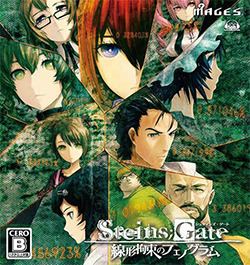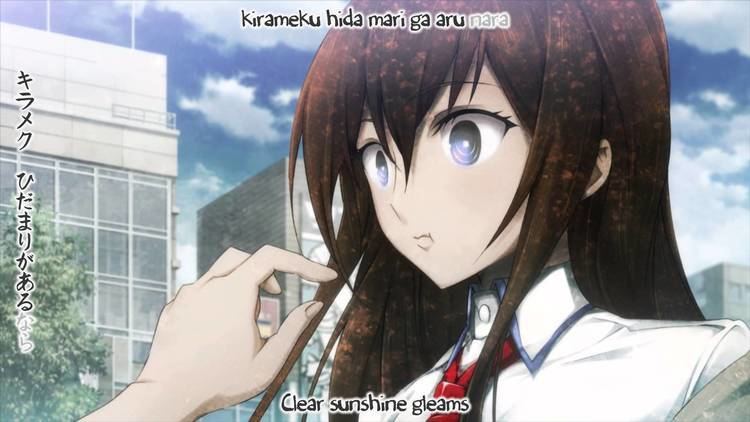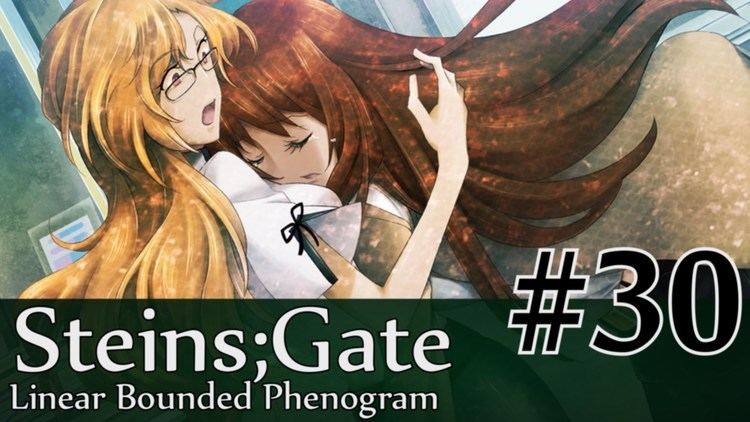Producer(s) Tatsuya Matsubara Writer(s) Naotaka Hayashi Initial release date 25 April 2013 Developer 5pb. Genre Visual novel | Artist(s) Huke Mode(s) Single-player Publisher 5pb. | |
 | ||
Similar Science Adventure games, 5pb games, Visual novel games | ||
Steins;Gate: Linear Bounded Phenogram, known in Japan as Steins;Gate: Senkei Kōsoku no Phenogram, is a visual novel video game developed by 5pb., released for the PlayStation 3, Xbox 360, and PlayStation Vita in 2013 and iOS in 2014. It is part of the Science Adventure series, and a spin-off from the 2009 game Steins;Gate. It consists of eleven side stories, which are set in different realities, and follow different Steins;Gate characters. By using the characters' cell phones to make different choices, the player affects the direction of the plot.
Contents

The game was produced by Tatsuya Matsubara, with character design by Huke. As 5pb.'s Chiyomaru Shikura felt that the Steins;Gate world had been fully concepted, he let a group of other writers create the game's story to bring new ideas to the series. Among these were Naotaka Hayashi, who had worked on previous Science Adventure titles and supervised the story, and Kotaro Uchikoshi, whose writing for the game was influenced by the anime series Code Geass. Reviewers liked the game, and enjoyed the use of multiple viewpoints in the story.

Gameplay

Linear Bounded Phenogram is a visual novel in which the player advances through text and dialogue to read through several short stories; by using the player characters' cell phones to make different choices and responses in the "phone trigger" system, the player can affect the direction of the game's plot. In the iPhone version of the game, the player picks up and puts down the in-game phone by holding the phone they are playing on vertically or horizontally, respectively.
Synopsis
Linear Bounded Phenogram is a spin-off from Steins;Gate, consisting of eleven side stories set in different realities, some of which are similar to the one in the original game, and some which are very different. Two of the stories follow Rintaro Okabe – the player character in the original Steins;Gate – while the rest follow other characters.
Development and release
Linear Bounded Phenogram was developed by 5pb., and was produced by Tatsuya Matsubara, with character designs by Huke. Unlike the original Steins;Gate, where 5pb.'s Chiyomaru Shikura came up with the story himself, the story of Linear Bounded Phenogram was crafted by a group of writers; when Shikura was working on the anime adaptation of Steins;Gate, he realized that the game's world was already "concepted out", which meant that he could let other writers who understand the world work on Steins;Gate projects, bringing new ideas into it. The script was written and supervised by Science Adventure series regular Naotaka Hayashi together with a number of other writers: Baio Shimokura, Masahiro Yokotani, Kiyomune Miwa, Teru Arai, Shogo Sakamoto, Masashi Kigasawa, Toru Yasumoto, Kougetsu Mikaduki, Keiji Akatsuki, and Kotaro Uchikoshi, who all wrote one scenario each. Uchikoshi did not work sequentially on his scenario, "Three Contrapasso About the Abduction", instead choosing to write in a "disordered" style, going back and forth and writing different parts in parallel. A large influence on his scenario was the anime series Code Geass (2006–2007), with the character Lelouch Lamperouge influencing Okabe's "wannabe bad guy" characterization. Shikura wrote the game's theme song, "Phenogram", which was performed by Ayane.
The game was first announced in November 2012 for an early 2013 release, and was released for the PlayStation 3 and the Xbox 360 on April 25, 2013. A PlayStation Vita version followed later in the same year, on November 28. While the story remains unchanged, some optimization of the game was done for the PlayStation Vita release. It was additionally released for iOS devices on August 19, 2014. The game is also available in two different limited editions: one for the PlayStation 3 and Xbox 360 versions, which includes a replica of Okabe's cell phone, and one for the PlayStation Vita version, which includes a DVD with a round-table discussion with the voice actors, and a set of Steins;Gate-themed bandages.
Reception
During the game's debut week, the PlayStation 3 and Xbox 360 versions were the fifth and sixteenth best selling games in Japan with 34,292 and 8,821 copies sold, respectively; the Xbox 360 version dropped off the top 20 chart the following week, while the PlayStation 3 version dropped to nineteenth place, selling an additional 5,144 copies for a grand total of 48,257 copies sold. In December 2013, Amazon.co.jp reported that the standard and limited editions of Linear Bounded Phenogram were their ninth and twentieth best selling Xbox 360 games of the year, respectively.
Richard Eisenbeis at Kotaku said that the game, like other Steins;Gate games, has excellent art. He noted that it was more serious than the two previous Steins;Gate spin-offs, and found it interesting to follow characters other than Okabe and seeing their thoughts, and enjoyed how they received a lot of character development. Famitsu's writers also enjoyed the multiple viewpoints, particularly that of the character Mayuri Shiina, and gave the game their "Gold Award". Patrick Gann of RPGFan enjoyed the game's opening themes, particularly "Phetaritette Encounter", the opening for the PlayStation Vita version, which he said was the most musically interesting piece by Ayane in the The Sound of Steins;Gate Complete music album.
